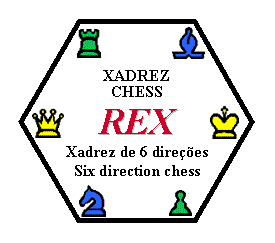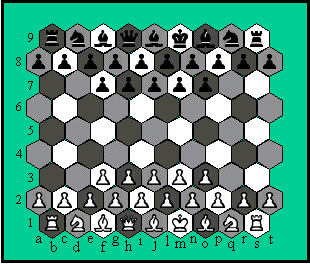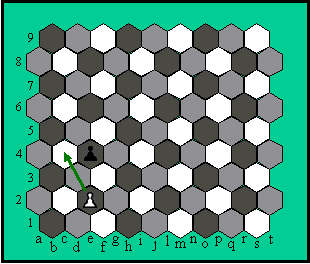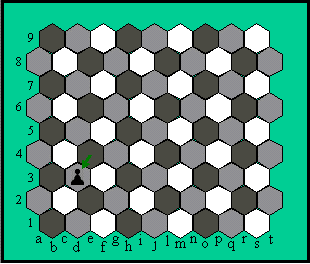
http://www.oocities.org/xadrezrex
Written by Arnaldo Rodrigues D'Almeida
Published in: April / 2002
Revised in: June/2002

2- Rules
Objective - The players have as objective to give Checkmate (to see further on) in the opponent.
Pieces
![]()
![]() Pawn
Pawn
![]()
![]() Rook
Rook
![]()
![]() Knight
Knight
![]()
![]() Bishop
Bishop
![]()
![]() Queen
Queen ![]()
![]() King
King
Disposition of the pieces - The pieces should be disposed in agreement with the Figure 1. The white pieces are positioned on the side of the board where the corner white hexagon is to the right. The King is always positioned in the white hexagon and the Queen, in the black hexagon.
Figure 1: Positioning the pieces at the beginning of the game.

Who starts - The player with the white pieces starts the game. Two games should be play in which the players should play once with the white pieces and another with the black pieces.
Time of the game - The players, before beginning the game, can agree to the maximum time each one will take to make their moves, as well as the total time of the game. If the players aren’t in agreement, the game will be played without demarcation of the time.
Movement of the pieces - The players will move the pieces, one per time, alternately. Each player should only move the pieces of his color. The pieces are moved in agreement with the Figure 2.
Figure 2: Movement of the pieces.

The Queen, not shown in the Figure, can be moved along the diagonal, as Bishop, or along the orthogonal, as Rook. The hexagons in the path of full arrows can be occupied in one move. The pieces can only occupy hexagons that are unoccupied or occupied by opposing pieces (of another color), if there are no other piece in the path. The Knight is the only piece that can jump the other ones, in other words, a piece in its path doesn't impede it of occupying an empty hexagon or an hexagon occupied by the opponent. The King cannot be moved to hexagons where it can be captured (to see Capture further on) by some opposing piece. The Pawn only moves forward. Except for the 5 Pawns of the first row of Pawns, Pawns can move two hexagons in straight line, in the first move, as long as those are not occupied by other piece of the game (Figure 3).
Pawn “En passant” - Soon after the Pawn moves two hexagons in one move, it can be captured by the opposing Pawn in the following move, and only in this move, as if it was in the first hexagon. If that happens, the opposing Pawn occupies the first hexagon, of the two that it moved, and other Pawn leaves the board (Figures 3 and 4).
Figure 3: Pawn advances two hexagons in first move.

Figure 4: Pawn captures Pawn “En passant”.

Coronation of the Pawn - The Pawn when arriving in the last row (where the opposing King is in the beginning of the game) it leaves the board, giving place the other piece, except King, to be chosen by the player.
Capture - When one piece occupies a hexagon occupied by an opposing piece, this piece leaves the board and it means that it has been captured.
Check / Checkmate - When some piece threatens to capture the opposing King (King in check), the player should pronounce the word "check" and indicate which piece that is threatening, if necessary. In the following move, the opponent necessarily must move or protect the King (to place a piece between the King and the piece that threatens the King), or capture the piece that threatens the King. In the impossibility of avoiding the menace, Checkmate is said. In this case, the player in that situation loses the game.
Win - The player wins the game when the opponent: (1) receives Checkmate, (2) gives up of the game (to abandon), at any moment or (3) terminate its time (for option of demarcation of the time).
Tie - The tie can happen when: (1) one of the players cannot move any of his pieces, (2) there are insufficient pieces to do a Checkmate, (3) to happen repetition of move by 3 serial times or (4) one of the players proposes tie to the opponent, what can happen at any moment of the game, and it is accepted by him.
Information or comments send e-mail to: chessrex@bol.com.br

|
1- Introduction |
|
2- Rules |
|
3- Notation |
|
4- The game |
|
5- Strategies |
|
6- Matches |
|
7- Problems |
|
8- Board |
|
9- Downloads |
|
10- Links |